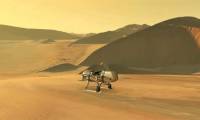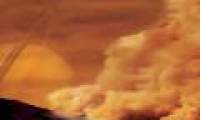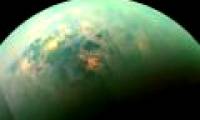
NASA has announced a $256.6 million contract with SpaceX, giving the company the responsibility of launching its Dragonfly propeller lander to Titan, Saturn's largest moon.

Of all our solar system bodies, Saturn's Titan moon is closest to Earth, with a stable liquid on the surface and a dense, nitrogen-rich atmosphere.

Complex organic molecules hidden in giant dust storms increase the hope of finding life on the moon that NASA has dubbed.

The study has just published in the Astrobiology scientific journal of the US scientists group of many units, using data that Cassini research spacecraft.

NASA has just released two stunning new images of Saturn's moon Titan, where scientists believe it is eligible to form extraterrestrial life.

Peter Bedini, director of the Dragonfly project, said the flying dragon's flying ability will help it to overcome geological obstacles more easily than previous equipment.

Scientists from the US Aeronautics and Space Agency (NASA) said Cassini spacecraft first discovered vinyl cyanide molecules on Saturn's moon Titan.

Saturn's Titan moon is the only place outside of Earth known for its liquid-filled surface.

The moon Titan holds enough energy to become a giant colony of humans, with the potential to hold up to 300 million people.

NASA has successfully tested the Cassini spacecraft with a flight between Saturn and its planet.
 NASA has announced a $256.6 million contract with SpaceX, giving the company the responsibility of launching its Dragonfly propeller lander to Titan, Saturn's largest moon.
NASA has announced a $256.6 million contract with SpaceX, giving the company the responsibility of launching its Dragonfly propeller lander to Titan, Saturn's largest moon. Of all our solar system bodies, Saturn's Titan moon is closest to Earth, with a stable liquid on the surface and a dense, nitrogen-rich atmosphere.
Of all our solar system bodies, Saturn's Titan moon is closest to Earth, with a stable liquid on the surface and a dense, nitrogen-rich atmosphere. Complex organic molecules hidden in giant dust storms increase the hope of finding life on the moon that NASA has dubbed.
Complex organic molecules hidden in giant dust storms increase the hope of finding life on the moon that NASA has dubbed. The study has just published in the Astrobiology scientific journal of the US scientists group of many units, using data that Cassini research spacecraft.
The study has just published in the Astrobiology scientific journal of the US scientists group of many units, using data that Cassini research spacecraft. NASA has just released two stunning new images of Saturn's moon Titan, where scientists believe it is eligible to form extraterrestrial life.
NASA has just released two stunning new images of Saturn's moon Titan, where scientists believe it is eligible to form extraterrestrial life. Peter Bedini, director of the Dragonfly project, said the flying dragon's flying ability will help it to overcome geological obstacles more easily than previous equipment.
Peter Bedini, director of the Dragonfly project, said the flying dragon's flying ability will help it to overcome geological obstacles more easily than previous equipment. Scientists from the US Aeronautics and Space Agency (NASA) said Cassini spacecraft first discovered vinyl cyanide molecules on Saturn's moon Titan.
Scientists from the US Aeronautics and Space Agency (NASA) said Cassini spacecraft first discovered vinyl cyanide molecules on Saturn's moon Titan. Saturn's Titan moon is the only place outside of Earth known for its liquid-filled surface.
Saturn's Titan moon is the only place outside of Earth known for its liquid-filled surface. The moon Titan holds enough energy to become a giant colony of humans, with the potential to hold up to 300 million people.
The moon Titan holds enough energy to become a giant colony of humans, with the potential to hold up to 300 million people. NASA has successfully tested the Cassini spacecraft with a flight between Saturn and its planet.
NASA has successfully tested the Cassini spacecraft with a flight between Saturn and its planet.




 NASA's 'Ninth Planet' Shows Signs of Being Friendly to Life
NASA's 'Ninth Planet' Shows Signs of Being Friendly to Life Why did American astronauts have to be quarantined when returning to Earth?
Why did American astronauts have to be quarantined when returning to Earth? China surprises the world by building a cable-stayed bridge 'above the clouds'
China surprises the world by building a cable-stayed bridge 'above the clouds' Why do women sleep less and wake up more than men?
Why do women sleep less and wake up more than men? Revealing the secret inside the stuffed animal claw machine, from there, summarizing experience to help you increase your winning rate many times over
Revealing the secret inside the stuffed animal claw machine, from there, summarizing experience to help you increase your winning rate many times over What would happen if you dug a hole through the Earth and jumped in?
What would happen if you dug a hole through the Earth and jumped in? Camera takes a photo that lasts 1,000 years
Camera takes a photo that lasts 1,000 years Was there nuclear war in ancient times?
Was there nuclear war in ancient times?